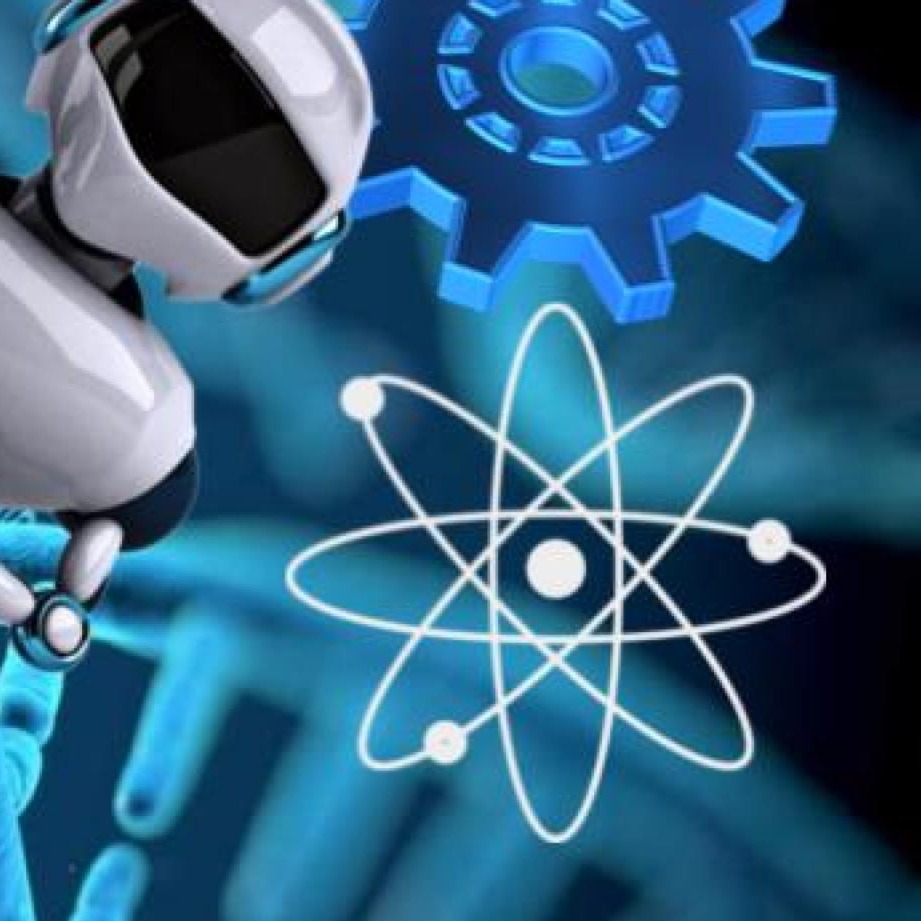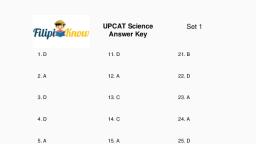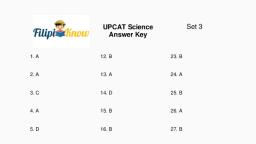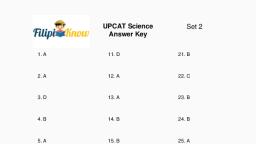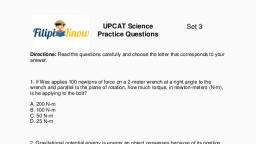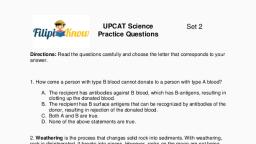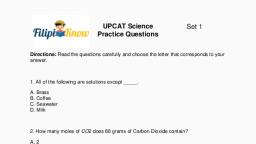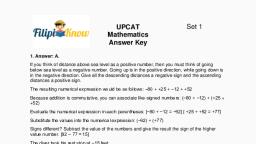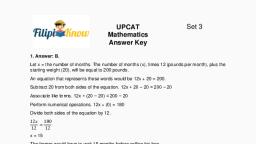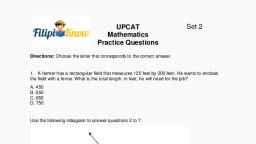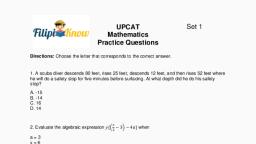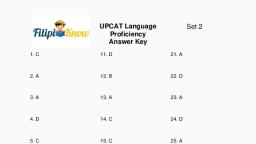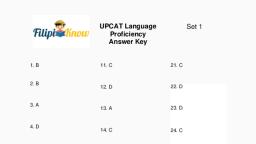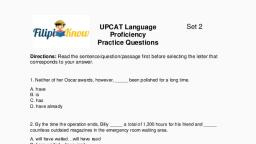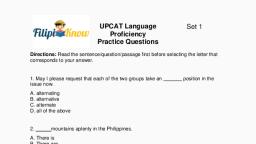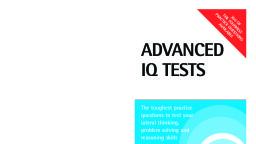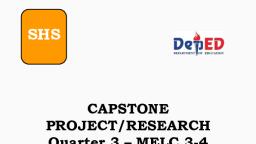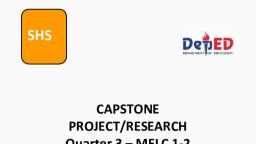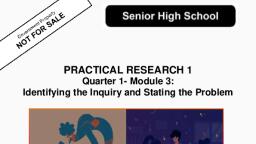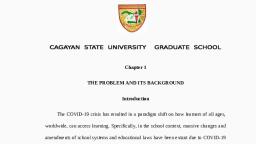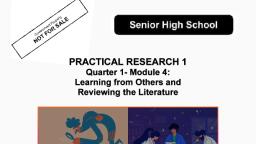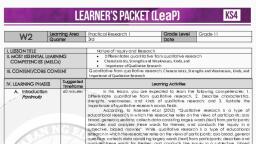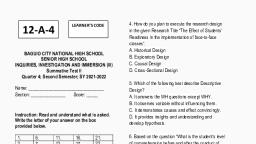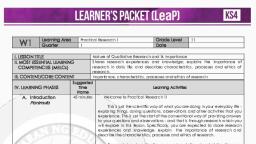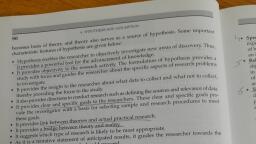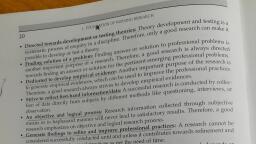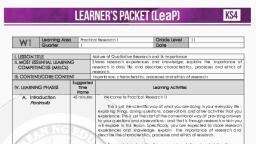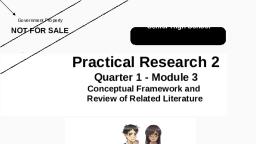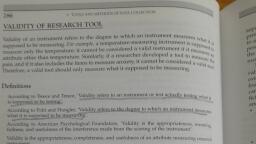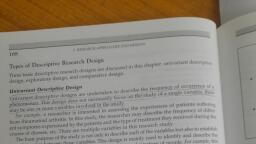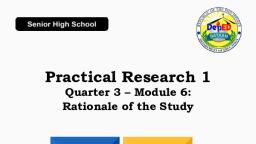Page 1 :
PRACTICAL RESEARCH 1, Quarter 1- Module 1:, Nature of Inquiry and Research, , Department of Education ● Republic of the Philip
Page 2 :
Lesson, , The Importance of Research in, , 1, , Daily Life, What’s in?, , In your junior high school, you learned that research is essential knowledge that it is used in your daily life. It, will enable you to inquiry and research in finding solutions to problems, especially in real-life situations. Sharing your, experiences and knowledge on the importance of research develops your skills to think critically and relate it to every, decision you do., , What’s New?, , I. What is Research?, 1. Research is defined as the scientific investigation of phenomena which includes collection, presentation,, analysis, and interpretation of facts that line an individual‘s speculation with reality., 2. Solutions to problems must be based on knowledge, not on mere beliefs, guesses, or theories., 3. In research a systematic and well-planned procedure is required to meet the need in order that information is, acquired and evaluate its accuracy and effectiveness., 4. It is a process of inquiring1., II. Nature of Inquiry., 1. Inquiry is defined as “a seeking for truth, information or knowledge”., It is a problem-solving technique., 2. The information and data pursued through questioning begin with gathering by applying the different human, senses., 3. Individuals carry on the process of inquiry from birth till death., 4. Inquiry is synonymous with the word investigation., III. Investigation and Immersion, An investigation has a deeper meaning compared to “inquiry”., It is a systematic examination of a certain event or phenomenon., Immersion is a process whereby a researcher immerses (deeply involved) himself in the data gathering activities and, the data he has gathered is carefully read or examined by him in detail., Combining the idea of “inquiry”, “investigation” and “immersion”, the concept of “research” comes in., IV. Differentiate Inquiry from Research, Inquiry is a term that is synonymous with the word ‘investigation’. When you inquire or investigate, you tend to ask, questions to probe or examine something to request truth, information, or knowledge., Research is systematic and objective creation of knowledge systematic (with a system or method, the scientific, method), objective (no bias, all angles presented), knowledge creation (a creative process), , 1
Page 3 :
V. Purpose of Research, 1. To inform action., 2. To prove or generate a theory., 3. To augment knowledge in a field of study., VI. Importance of Research in Daily Life, 1. Research directs us to inquire about the right information by conducting further investigation of the actual, condition. It leads us to be cautious in giving results and findings by proving lies and supporting the truth., 2. Research empowers us with knowledge and discovers new things and issues in life. It helps us solve problems, in health, crimes, business, technology, and the environment., 3. Research facilitates learning as an opportunity to share valuable information with others as a way of, recognizing various concerns for public awareness., , What is it?, Discussion of Activity 1, You just learned the importance of research in daily life. Answer the following questions briefly on the blanks, provided., 1. Was there an instance in your life when you did an inquiry or research? Share and describe your, experiences. What are your challenges and difficulties?, _________________________________________________________________________________________, _________________________________________________________________________________________, _________________________________________________________________________________________, _________________________________________________________________________________________, ____________________________, 2. As a learner in senior high school, how important is research in your daily life?, ______________________________________________________________________________________, ______________________________________________________________________________________, ______________________________________________________________________________________, ______________________________________________________________________________________, , What’s more?, , Direction: What makes these images a portrayal of what research is?, Write your reflection on the right space of the image., 1., , 2
Page 4 :
2., , 3., , 4., , What I have learned, Let’s check how well do you know about research. Write your answers on the space provided., 1. Research is different from inquiry because the later will ask you a question. If inquiring is synonymous with, investigation then what makes inquiry different from research which also investigates?, ______________________________________________________________________________________, ______________________________________________________________________________________, ______________________________________________________________________________________, ______________________________________________________________________________________, 2. Research in our daily life help us to understand various issues in life leading to a solution, in what way does, research empowers you with knowledge to learn new things?, ______________________________________________________________________________________, ______________________________________________________________________________________, _____________________________________________________________________________________, What I can do, , Direction. Answer the following question., 1. What is the importance of research in your education as a 21st Century learner?, ____________________________________________________________________________________________, ____________________________________________________________________________________________, 2. As a learner, what do you want to research on? Why?, , 3
Page 5 :
Additional Activities, , Interview your classmate or a friend about their plans after senior high school. Ask them how research played, a major role in their chosen track or strand. Make a report about it and share it with your teacher., Write your report using a narrative format. Make use of the notes you wrote down before and after you conducted, your interview to flesh out the report. The first is the brief detail about what the report is, who is the interviewee, and, the location of the interview. Then break up the interview into paragraphs, like narrating a story and finally a conclusion, paragraph to end your report., , Lesson, , The Characteristics, Processes, and Ethics of Research, , 2, Research is a process of gathering, analyzing, and interpreting information to answer questions. A good, research follows processes that must have certain characteristics. It must be systematic, controlled, rigorous, valid, and verifiable, empirical and critical. To avoid unethical practices researchers had obligations to adhere to professional, standards in conducting research. Thus to consider research writing ethical it must be clear, accurate, just, and, authentic., ., , What’s in?, (, In the previous lessons, you learned the meaning of research and its importance in your daily life. Research, is different from inquiry. When you inquire or investigate, you tend to ask questions to probe or examine something to, request truth, information, or knowledge. The importance of research helps improve life as well as find a solution to, problems through reliable and validated information., , What’s New?, , I. Characteristics of Research, 1. Empirical. Research is based on direct experience or observation by the researcher., 2. Logical. Research is based on valid procedures and principles., 3. Cyclical. Research is a cyclical process because it starts with a problem and ends with a problem., 4. Analytical. Research utilizes proven analytical procedures in gathering the data, whether historical, descriptive and, experimental, or case study., 5. Critical. Research exhibits careful and precise judgment., 6. Methodical. Research is conducted in a methodical manner without bias using systematic methods and, procedures., 7. Replicability. The research design and procedures are replicated or repeated to enable the researcher to arrive at, valid and conclusive results, , 4
Page 6 :
II. The Seven Steps of the Research Process, Step 1. Define and develop your topic (Research Problem)., ❖ Factors to Consider in Selecting a Research Problem, 1. Researcher‘s area of interest, 2. Availability of funds, 3. Investigator‘s ability and training, Step 2. Find background information about your chosen topic (Review of Related Literature)., Step 3. Plan your research design including your sample (Methodology)., Step 4. Gather necessary data using open-ended questions (for qualitative research) and closed-ended, questionnaire or paper-pencil test questionnaire (for quantitative research) (Data Gathering Activities)., Step 5. Process and analyze data using thematic analysis (for qualitative research) and statistical tools (for, quantitative research)., Step 6. Formulate new insights gained (for qualitative research) conclusions (for quantitative research) and, recommendations., Step 7. Define a new problem., , III. Ethics in Research, Research ethics are guidelines for the responsible conduct of research that educate and monitor researchers to ensure, high standards promote the aim of the research, such as expanding knowledge and supporting the values required for, collaborative work, such as mutual respect and fairness., , ❖ Ethical considerations in conducting research, 1. Objectivity and integrity, 2. Respect of the research subjects ‘right to privacy and dignity and protection of, subjects from personal harm, 3. Presentation of research findings, 4. Misuse of research role, 5. Acknowledgement of research collaboration and assistance, 6. Distortions of findings by the sponsor, ❖ What are these ethics in research1?, 1. Informed Consent. This is required to secure in order to protect the rights of the participants in your study. Inform, your participants about the criteria set for choosing them as informants and the schedule of the one-on-one interviews, at the convenient time they are available. Participation in the study will be completely voluntary., 2. Honesty. It reports data, results, methods and procedures, and publication status. Do not fabricate, falsify and, misrepresent the data., 3. Objectivity. Avoid bias in experimental design, data analysis, data interpretation, peer review, personnel decisions,, grant writing, expert testimony, and other aspects of research., 4. Integrity. Keep your promises and agreements; act with sincerity; strive for consistency of thought and action., 5
Page 7 :
5. Carefulness. Avoid careless errors and negligence; carefully and critically examine your work and the work of your, peers. Keep good records of research activities., 6. Openness. Share data, results, ideas, tools, and resources. Be open to criticism and new ideas., 7. Respect for Intellectual Property. Honour patents, copyrights, trademarks, trade secrets, and other forms of, intellectual property. Do not use published or unpublished data, methods, or results without permission. Give credit, where credit is due. Never plagiarize, fabricate and falsify., 8. Confidentiality. Protect confidential communications, such as papers or grants submitted for publication, personnel, records, trade or military secrets, and patient records., 9. Responsible Mentoring. Help to educate, mentor, and advise others. Promote their welfare and allow them to make, their own decisions., 10. Responsible Publication. Publish in order to advance research and scholarship, not to advance your own career., Avoid wasteful and duplicative publication., 11. Respect for Colleagues. Respect your colleagues’ opinions, treat them fairly, and do not outsmart others., 12. Social responsibility. Strive to promote social acceptance and prevent or mitigate social harms through research,, public education, and advocacy., 13. Non-discrimination. Avoid discrimination against colleagues or students on the basis of sex, race, ethnicity, or, other factors that are not related to their scientific competence and integrity., 14. Competence. Maintain and improve your own professional competence and expertise through lifelong education, and learning; take steps to promote competence in science as a whole., 15. Legality. Know and obey relevant laws and institutional and government policies., 16. Animal Care. Show proper respect and care for animals when using them in research. Do not conduct unnecessary, or poorly designed animal experiments., 17. Human Subjects protection. When conducting research on human subjects, minimize harms and risks and, maximize benefits; respect human dignity, privacy, and anonymity., IV.Rights of Research Participants, 1. Human Rights. They are moral principles or norms that describe certain standards of human behavior and are, regularly protected as natural and legal rights. They constitute a set of rights and duties necessary for the protection, of human dignity, inherent to all human beings., 2. Intellectual Property. It protects creations of the mind, which have both a moral and a commercial value., 3. Copyright Infringement. It is the use or production of copyright-protected material without the permission of the, copyright holder. Copyright infringement means that the rights accorded to the copyright holder, such as the exclusive, use of a work for a set period of time, are breached by a third party, Examples:, a. Downloading movies and music without proper payment for use., b. Recording movies in a theatre, c. Using others’ photographs for a blog without permission, d. Copying software code without giving proper credit, e. Creating videos with unlicensed music clips, 6
Page 8 :
4. Voluntary Participation. People must not be coerced into participating in research process. Essentially, this means, that prospective research participants must be informed about the procedures and risks involved in research and must, give their consent to participate., 5. Anonymity. It is the protection of people’s identity through not disclosing their name or not exposing their identity. It, is a situation in data gathering activities in which informant’s name is not given nor known., 6. Privacy. It is someone’s right to keep his personal matters and relationships secret. It is the ability of an individual, to seclude him from disturbance of any research activity., , V. Ethical Standards in Research Writing, Research Misconduct includes fabrication, falsification, or plagiarism. It doesn’t include honest errors or differences of, opinion. It can erode trust between researchers and funding agencies, which makes it more difficult for colleagues at, the same institution to receive grants., Plagiarism, Plagiarism refers to the act of using another person’s ideas, works, processes, and results without giving due, credit. It should not be tolerated as the unauthorized use of original works, a violation of intellectual property rights., Three different acts are considered plagiarism:, 1. Failure to cite quotations and borrowed ideas,, 2. Failure to enclose borrowed language in quotation marks, and., 3. Failure to put summaries and paraphrases in your own words., , Activity 1: Question and Answer, Directions: Answer the questions briefly. Write your answers in the space provided., 1. Why is research practical and realistic?, ____________________________________________________________________________________________, ____________________________________________________________________________________________, 2. The first step of the research process is to develop your topic or research problem. What is the importance of, considering those factors in selecting a research problem?, ____________________________________________________________________________________________, ____________________________________________________________________________________________, 3. Explain briefly. Research starts with a problem and ends with a new problem., ____________________________________________________________________________________________, ____________________________________________________________________________________________, 4. What is the purpose of research ethics in doing research work?, ____________________________________________________________________________________________, ____________________________________________________________________________________________, 5. A research can be replicated but not the findings. Why?, ____________________________________________________________________________________________, ____________________________________________________________________________________________, , 7
Page 9 :
What’s more?, , Read and Analyze, Direction: Read the following articles below and answer the questions that follow. Write your answer on a separate, sheet of paper., Ethics in Qualitative Research, Certain ethical challenges in qualitative research necessitate sustained attention of two, interconnected worlds: the world of the researcher and the world of the participant. A critical view of some, of the ethical challenges in the participants’ andresearchers’ world reveals that how we examine both, these worlds’ effects how we design our research. In addition, it reflects the need for researchers to, develop an ethical research vocabulary at the inception of their research life through multiple modes. The, modes may include dialogue in the spoken and written and visual to affect their aims to adhere to the, principles of respect, beneficence, nonmaleficence, and justice in a way that is mutually beneficial to the, participant and the researcher.1, Further, the deliberations in this paper reveal that a critical conscious research ethics are embedded, in the unfolding research ethics process involving the participants and the researchers, and both the, participant and researcher add equal weight to the transparency of the ethical process and add value to, building methodological and ethical rigor to the research.1, The global public health response to COVID-19 could be significantly enhanced by safe, effective, vaccines and treatments, reliable measures of correlates of immune protection, and improved scientific, knowledge of the disease and its transmission. It is widely agreed that vaccines would be particularly, important, and over 100 candidate vaccines are currently being developed . Well designed human, challenge studies provide one of the most efficient and scientifically powerful means for testing, vaccines, especially because animal models are not adequately generalizable to humans., Challenge studies could thus be associated with substantial public health benefit in so far as they (a), accelerate vaccine development, (b) increase the likelihood that the most effective (candidate) vaccines, will ultimately become available), (c) validate tests of immunity, and (d) improve knowledge regarding, SARS-CoV-2 infection and transmission., Questions:, 1. Based on the article, how will you define ethics in research?, ____________________________________________________________________________________________, ____________________________________________________________________________________________, 2. Are SARS-CoV-2 infection and transmission studies on humans rather than animal models unethical?, ____________________________________________________________________________________________, ____________________________________________________________________________________________, 3. If you were a part of the research teams conducting such a phenomenon, what will you do to correct the, unethical feature of the experiment?, ____________________________________________________________________________________________, ____________________________________________________________________________________________, , 8
Page 10 :
Lesson, , Quantitative and Qualitative Research, , 3, Research has two broad methodologies; qualitative research and quantitative research. Quantitative and, qualitative researches are complementary methods that you can combine in your research studies to get results that, are both wide-reaching and profound. To get the best results from these methods in your research, it’s important that, you understand the differences between them which you will study in this lesson., , What’s New?, , I. When to use Qualitative vs. Quantitative Research, Quantitative data can help you see the big picture., Qualitative data adds the details and can also give a human voice to your survey results., Concept Map showing the Designs of Research., , DESIGN, , TYPES, , Ethnography, , Experimental Research, , Grounded Theory, , 1. Pre-Experimental, 2. True-Experimental, 3. Quasi-Experimental, , Case Study, Discourse Analysis, Phenomenology, Historical Research, , Non-Experimental, Research, , Narrative Report, Biography, , (Survey Research), , 1. Scholarly Chronicle, 2. Intellectual, Biography, 3. Life History Writing, 4. Memoir Biography, 5. Narrative Biography, , 1. Descriptive Research, 2.Comparative Research, 3.Correlational Research, , Action Research, 9
Page 11 :
II. Difference: Qualitative Research versus Quantitative Research2, Qualitative, It aims to create a new theory based on, the gathered data., , Quantitative, The purpose is to test a hypothesis or, theory., , Fact-finding research is used to gain an, understanding of individual differences, in terms of feelings and experiences., , Measures problem using a rating, scale and other research parameters, of group similarities., , -natural setting, , -measurement setting, , -making stories out of a certain, phenomenon., , -performs measures out of a certain, phenomenon., , -Uses pictures, words, sentences,, paragraphs, compositions, narrations, and short stories, , - Uses numbers, scales, hypotheses,, calculations, computations, and, statistics tools., , Sample (size), , Small judgment (by decision) sampling, , Large sample representatives of the, population, , Data Gathering, , Unstructured, or, (flexible processes), , Standardized /Structured, , Objective, , Data Description, , semi-structured, , Uses, interviews,, participant, observation, group discussions., Ex: Case Study, field research, Uses open-ended questions., It is a freeform survey question that, allows a participant to answer in opentext format, responses are unlimited to, a set of options., , Example:, Guide questions for the interviews, 1. What were your experiences during, the quarantine period on the COVID-19, pandemic? How did you handle the, situation caused by the pandemic?, 2. Was the support of the National and, Local Government enough for your, basic needs? Did they conduct, evaluations for those who were, affected?, , Inductive, , Uses census, survey questionnaire,, checklist, paper-pencil test, and, experimentation., Uses closed-ended questions., These questions can only be, answered by selecting from a limited, number of options, usually “multiplechoice”, “yes or no”, or a rating scale, Example:, Strongly agree to strongly disagree, In quantitative research closed-ended, questions is the basis of all statistical, analysis techniques applied on, questionnaires and surveys., Sample Question:, Do you agree on online modality, classes in transitioning to the new, normal of education?, a. Strongly agree, b. Agree, c. Disagree, d. Strongly disagree, Deductive, , 10
Page 12 :
Activities, , The researcher starts with the, observations, an open mind without, biases, gathering all exact details of the, topic, and generalization or new theory, is given towards the end of the research, process., , Starts from a hypothesis or already, created theory emphasizing the, previously researched phenomenon, from different views (tested against, observations)., , Uses both inductive and deductive, They are not mutually exclusive with each other in research., , Data discussions, and Presentation, , The inductive method or “bottom-up” is used if the researcher starts discussions, from the lowest and highest means then explains the overall mean., Deductive or “top-down “if the discussion is from the overall mean going to the, lowest and highest means, deductive., Opinions are based on experience or Opinions are based on laws, rules, or, observation. There are no criteria, other recognized principles., used in data discussions., , Synthesize data, interpret, thematic., , Statistical, , Subjective, Objective, Data Analysis, , Data analysis is influenced, personal experiences and views., , by, The researcher employs standard, criteria in analyzing data., , Cultivates understanding with high, validity., , Endorse a development., Has high output replicability., , There are no conclusions formulated., , The conclusion is formulated towards, the end of the research process., , Outcome, , III. Similarities: Qualitative Research and Quantitative Research, 1. Both have the process of inquiry and investigation., 2. Both improve life and help us in understanding various issues of life and in giving solutions to our problems, 3. Both start with a problem and end with a new problem., 4. Both use textual forms in analyzing and interpreting of data., 7. Both use inductive and deductive methods of presenting data., , What I have learned, Complete the box by filling out the missing description of qualitative or quantitative research., Qualitative Research, 1., , Quantitative Research, Dependent on statistical tools, , Uses open-ended questions, , 2., , Inductive in data gathering activities., , 3., 11
Page 14 :
Lesson, 4, , The Kinds of Research Across Fields, , Developing an interest in different kinds of research will help you look into something that affects your, personality or your life in some important way. If you are interested in a topic you are researching, you will enjoy, reading and learning about it. To define clearly the types of research in areas of interest you want to embark on, focus, your scientific skills, your passion, and your ideas. It supports you to connect to your, career path. The examples of research in areas of interest will lead you to choose a specific topic of your research, study which you will be exploring to create new knowledge., , What’s New?, I. Kinds of Research across Fields, Areas of Interest, Arts-Based, Research, , Description, , Example of Studies, , Personal expression in various art forms is, use as a primary mode of inquiry, , 1.The Role of Arts in Student Achievement, in Reading, 2.How, Classroom, Motivates Learning, , Research in, Humanities, , Deals with human culture such as, philosophy, religion, literature, linguistics,, and history, It includes ancient and modern languages,, human geography, laws, politics, and other, social sciences., , Sports Research, , Intended for athletes to endure their health, and wellness goals through proven highquality products., It helps the coaches and athletes to access, information and apply it to develop programs, and techniques in sports., , Science Research, , Artistic, , Structure, , 1 Values Education in the Public Schools:, Practices and Challenges, 2. Children In-Conflict with the Law: A, Resolution and Intervention, , 1. Student Involvement in Athletics and, their Academic Performance, 2. Sports and Fitness Support on Students, in Public Schools, , Discover laws, postulate theories that can, explain natural or social phenomena., , 1. Utilization of Garbage and other Waste, Resources as Cleaning Materials, , Applies systematic and constructed scientific, method to obtain, analyze and interpret data., , 2. Making of COVID -19 Cure out of Heat, Transfer, , A strong and testable hypothesis is a, fundamental part of scientific research., , 13
Page 15 :
Mathematics, Research, , Agriculture Research, , Provides mathematics mastery topics and, helps develop confidence and interest to, solve more mathematical problems., , 1., Student, Mathematics:, Interventions, , Difficulties, in, Remediation, , General, and, , It may also assist to find new methods to, simplify calculations., , 2. A Systemic Approach to Changing, Classroom, Practices, for, Enhancing, Mathematics Outcomes, , Improves productivity and quality of crops, irrigation, storage methods, effective farm, management, and marketing of agricultural, resources., , 1. Green Space in School: Social and, Environment Perspective, 2. Is Urban Gardening a Source of WellBeing?, , Agriculture is the backbone of the economic, system providing food, raw material, and, employment opportunities., Increase the productivity and management, of fishery resources to provide food: protect, and maintain different bodies of water for, sustainable supply of aquatic resources., , 1. Finding a Future: Sustaining Inland, Fishery, , Information and, Communication, Technology (ICT), Research, , Aim, to, adapt, current, technology, advancement, which, enhances, the, development of resources., , 1. The Role of ICT in the New Normal, Education, , Business Research, , Acquire information in business to maximize, sales and profit. It aids business companies, regulates which product or service is most, profitable or in demand., , 1. Developing a Framework for Small, Scale Business, , Finds solutions for human behavior, gathering information about people and, societies., , 1. The Impact of COVID-19 Pandemic on, Employment Opportunities, , Fisheries research, , Social Science, Research, , 2. Fishing for Change: Fishery Policy in the, Philippines, , 2. Exploring the Interactive Computer, Simulation in Public Schools, , 2. Business Practices and Strategies of, Small Enterprises at Limketkai Mall, , 2. Implementation of Enhanced Community, Quarantined in Low-Risk Area of, Misamis.Oriental., , 14
Page 16 :
What is it?, Discussion of Activity 1, You just learned the kinds and samples of research in areas of interest. Answer the following questions on the, space provided., 1. What are your views on using the samples of the research papers presented previously in areas of your interest?, , 2. Can you write your qualitative research proposal through the use of such patterns from the sample research paper?, , What’s more?, , Enrichment Activity, Direction: Compare and Contrast. Write on a separate sheet of paper., Choose two types of research from the different areas of interest like those in the field of arts, humanities, sports,, science, mathematics, business, agriculture, fisheries, ICT, and social science. Be able to differentiate your chosen, topics. Highlight their similarities and differences., , What I have learned, Identify the specific area of interest for each given topic by writing the letter of each type in the correct column., Likewise, below the letter representing your answer, write the importance of such research in your daily life., Arts-Based, , A., B., C., D., E., , Humanities, , Science, , ICT, , Digital Age, Child in Conflict with the Law, Classroom Environment, Herbal Medicines, Financial Management, 15, , Business
Page 17 :
Additional Activities, , Think of your own topic for research that you would like to work on. Keep in mind what you have learned, from this lesson to justify the specific research type for each chosen topic. Write your “top two” most interesting, topics below., , 1), , 2), , 16
